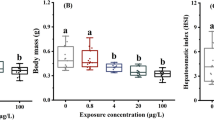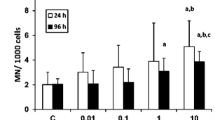Abstract
Although hexavalent chromium Cr [VI] is known as a toxicant in the aquatic environment, its effect in low, environmentally relevant concentration (ERC; 2 mg L−1) is less characterized. Against this backdrop, the effects of Cr [VI] in ERC on zebrafish liver has been investigated in this study. Fluorescence microscopy and gel electrophoresis detected excess DNA damage and cell death via apoptosis in 2 mg L−1 Cr [VI]-treated fish when compared with that of control. Besides, there were transcriptional activations of p53, Bax, Caspase 9 and Caspase 3 genes but downregulation of Bcl2 gene in the treated group, confirming the apoptotic pathway. Energy dispersive X-ray fluorescence (EDXRF) data showed significant (p < 0.05) increase in hepatic content of Cr, selenium, iron, manganese, calcium, sulfur and magnesium but depletion of zinc, copper and cobalt in the treated group. Collectively, the study shows that even a low, ERC of Cr [VI] is toxic to the zebrafish as it elicited marked apoptosis in the hepatocytes and altered the liver elemental profile.






Similar content being viewed by others
References
Agalakova NI, Gusev GP (2012) Molecular mechanisms of cytotoxicity and apoptosis induced by inorganic fluoride. ISRN Cell Biol 2012:1–16
Bakshi A, Panigrahi AK (2018) A comprehensive review on chromium induced alterations in fresh water fishes. Toxicol Rep 5:440–447
Balachandran RC, Mukhopadhyay S, McBride D et al (2020) Brain manganese and the balance between essential roles and neurotoxicity. J Biol Chem 295:6312–6329
Catelas I, Petit A, Vali H et al (2005) Quantitative analysis of macrophage apoptosis vs. necrosis induced by cobalt and chromium ions in vitro. Biomaterials 26:2441–2453
Chiu A, Shi XL, Lee WKP et al (2010) Review of chromium (VI) apoptosis, cell-cycle-arrest, and carcinogenesis. J Environ Sci Health C 28:188–230
Dey Bhowmik A, Podder S, Mondal P et al (2020) Chronic exposure to environmentally relevant concentration of fluoride alters Ogg1 and Rad51 expressions in mice: Involvement of epigenetic regulation. Ecotoxicol Environ Saf 202:110962
Elmore S (2007) Apoptosis: a review of programmed cell death. Toxicol Pathol 35:495–516
El-Sayed YS, Lebda MA, Hassinin M et al (2015) Chicory (Cichorium intybus L.) root extract regulates the oxidative status and antioxidant gene transcripts in CCl 4-induced hepatotoxicity. PLoS ONE 10:e0121549.
Fuchs SY, Adler V, Pincus MR et al (1998) MEKK1/JNK signaling stabilizes and activates. Proc Nat Acad Sci 95:10541–10546
Hyun HJ, Sohn JH, Ha DW et al (2001) Depletion of intracellular zinc and copper with TPEN results in apoptosis of cultured human retinal pigment epithelial cells. Invest Ophthalmol vis Sci 42:460–465
Lazo P (2009) Determination of Cr (VI) in environmental samples evaluating Cr (VI) impact in a contaminated area. J Int Environ Appl Sci 4:207–213
Liu K, Liu PC, Liu R et al (2015) Dual AO/EB staining to detect apoptosis in osteosarcoma cells compared with flow cytometry. Med Sci Monit Basic Res 21:15–21
Majtnerová P, Roušar T (2018) An overview of apoptosis assays detecting DNA fragmentation. Mol Biol Rep 45:1469–1478
Mohamed AAR, El-Houseiny W, Abd Elhakeem EM et al (2020) Effect of hexavalent chromium exposure on the liver and kidney tissues related to the expression of CYP450 and GST genes of Oreochromis niloticus fish: role of curcumin supplemented diet. Ecotoxicol Environ Saf 188:109890
Mukhopadhyay D, Priya P, Chattopadhyay A (2015) Sodium fluoride affects zebrafish behaviour and alters mRNA expressions of biomarker genes in the brain: role of Nrf2/Keap1. Environ Toxicol Pharmacol 40:352–359
Prashanth L, Kattapagari KK, Chitturi RT et al (2015) A review on role of essential trace elements in health and disease. J NTR Univ Health Sci 4:75–78
Rouault TA (2012) Regulation of iron metabolism in mammalian cells. In: Iron physiology and pathophysiology in humans. Humana Press, Walmart, pp 51–62
Ryoo HD, Gorenc T, Steller H (2004) Apoptotic cells can induce compensatory cell proliferation through the JNK and the Wingless signaling pathways. Dev Cell 7:491–501
Saadat YR, Saeidi N, Vahed SZ et al (2015) An update to DNA ladder assay for apoptosis detection. BioImpacts 5:25–31
Shaw P, Chattopadhyay A (2020) Nrf2–ARE signaling in cellular protection: Mechanism of action and the regulatory mechanisms. J Cell Physiol 235:3119–3130
Shaw P, Mondal P, Bandyopadhyay A et al (2019) Environmentally relevant concentration of chromium activates Nrf2 and alters transcription of related XME genes in liver of zebrafish. Chemosphere 214:35–46
Shaw P, Mondal P, Bandyopadhyay A et al (2020) Environmentally relevant concentration of chromium induces nuclear deformities in erythrocytes and alters the expression of stress-responsive and apoptotic genes in brain of adult zebrafish. Sci Total Environ 703:135622
Srivastava R, Sengupta A, Mukherjee S et al (2013) In vivo effect of arsenic trioxide on Keap1-p62-Nrf2 signaling pathway in mouse liver: expression of antioxidant responsive element-driven genes related to glutathione metabolism. ISRN Hepatol 2013:1–13
Taju G, Majeed SA, Nambi KSN et al (2017) Application of fish cell lines for evaluating the chromium induced cytotoxicity, genotoxicity and oxidative stress. Chemosphere 184:1–12
Acknowledgements
The authors express their gratitude to the Centre for Advanced Studies (CAS)-Phase II programmer of University Grants Commission, New Delhi. PS is grateful to UGC for the Meritorious Fellowship. PM is grateful to the Council of Scientific & Industrial Research for his Fellowship. ADB is grateful to the DST-INSPIRE fellowship. The authors are grateful to SAIC, Tezpur University (Assam) for the AAS studies to determine the concentration of Cr in treatment water.
Author information
Authors and Affiliations
Corresponding author
Ethics declarations
Conflict of interest
The authors declare that there is no conflict of interest.
Additional information
Publisher's Note
Springer Nature remains neutral with regard to jurisdictional claims in published maps and institutional affiliations.
Rights and permissions
About this article
Cite this article
Shaw, P., Mondal, P., Dey Bhowmik, A. et al. Environmentally Relevant Hexavalent Chromium Disrupts Elemental Homeostasis and Induces Apoptosis in Zebrafish Liver. Bull Environ Contam Toxicol 108, 716–724 (2022). https://doi.org/10.1007/s00128-021-03427-w
Received:
Accepted:
Published:
Issue Date:
DOI: https://doi.org/10.1007/s00128-021-03427-w




